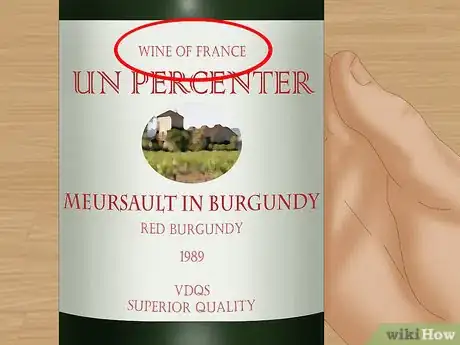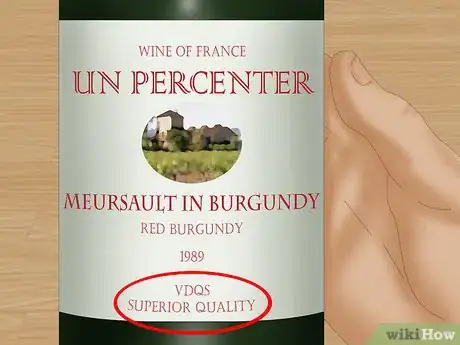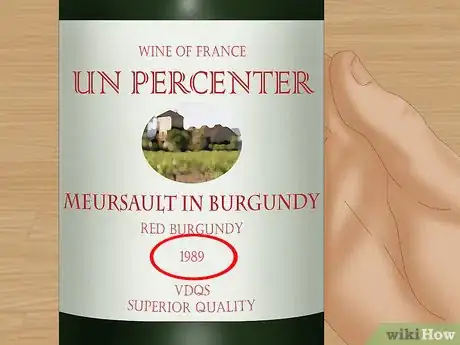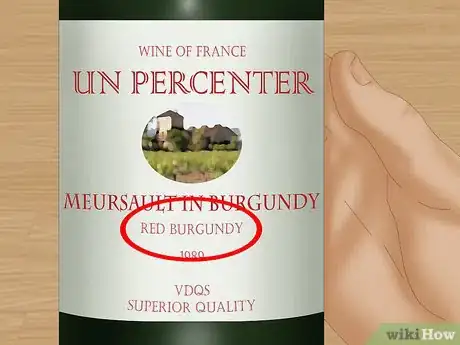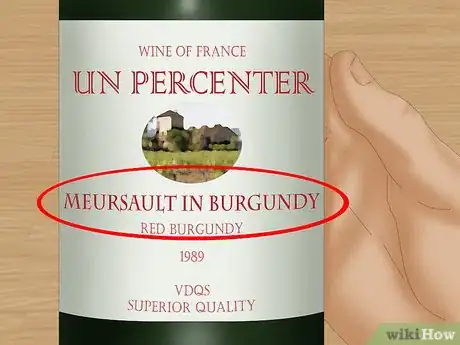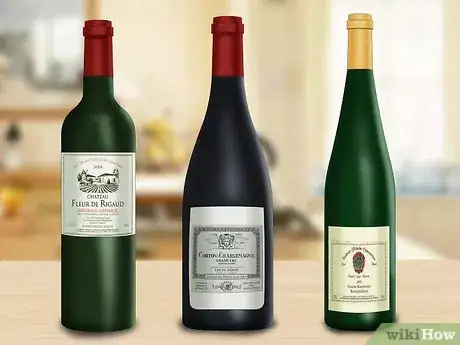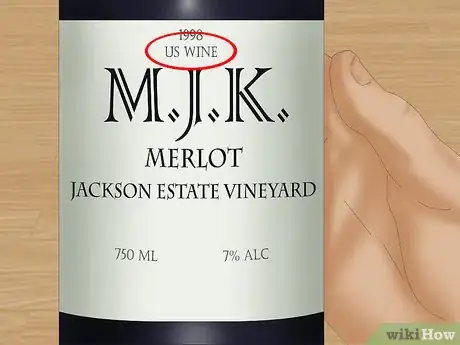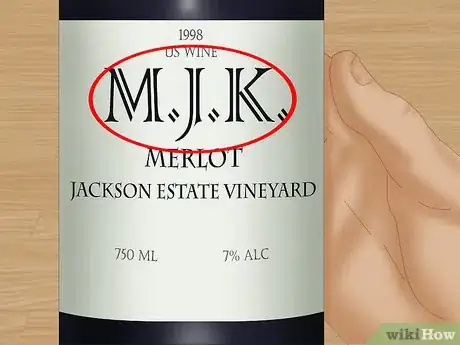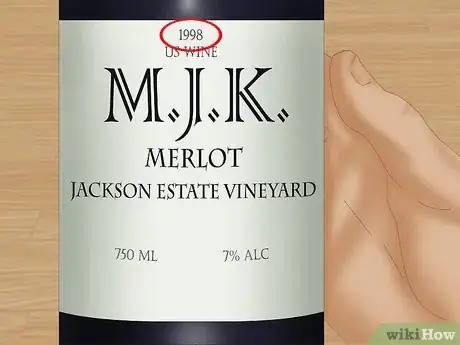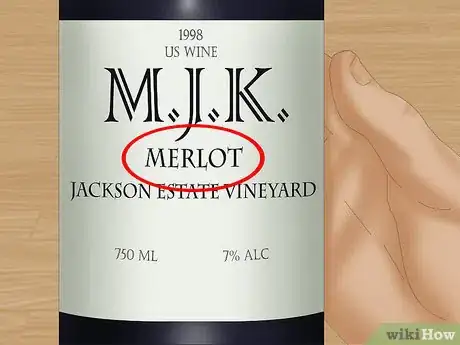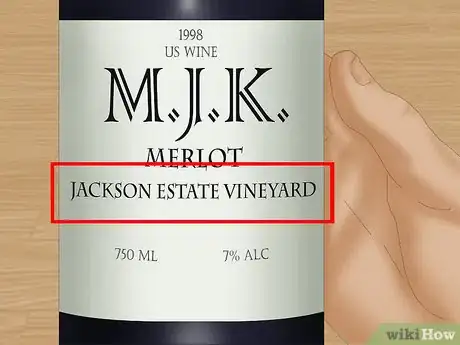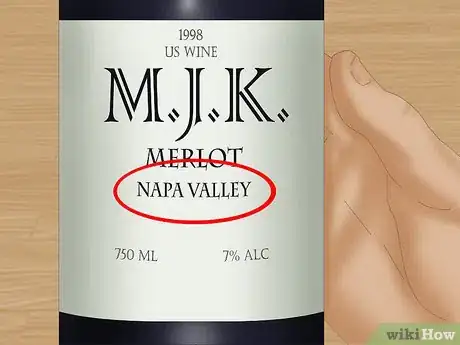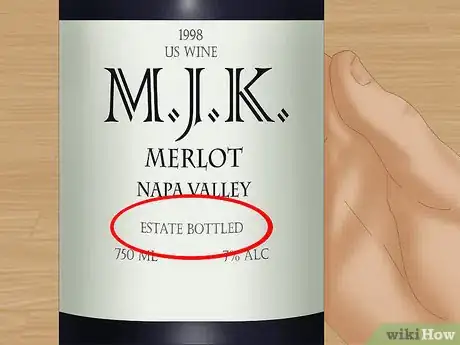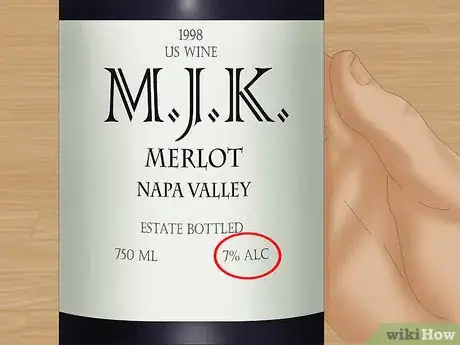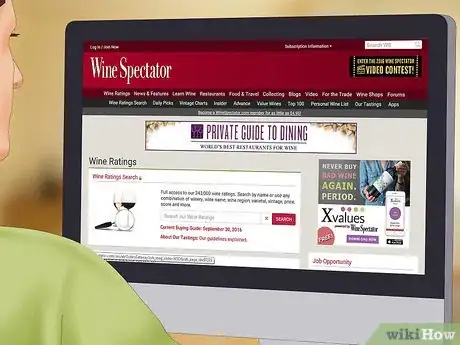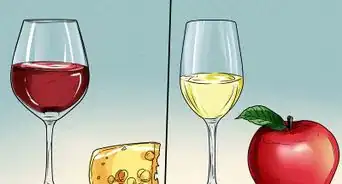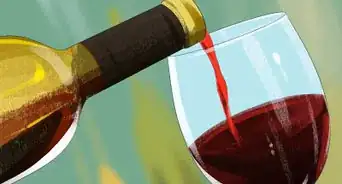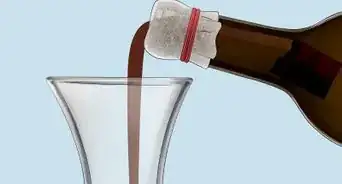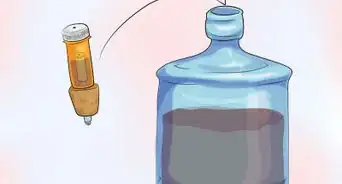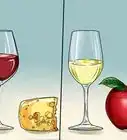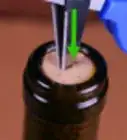This article was co-authored by Samuel Bogue. Samuel Bogue is a sommelier based in San Francisco, California. He is the Wine Director of the renouned Ne Timeas Restaurant Group and a wine consultant for other top restaurants in the San Francisco Bay area. He gained his Sommelier certification in 2013, and since then has been recognized as a Zagat "30 Under 30" award winner and a Star Chefs Rising Star.
There are 10 references cited in this article, which can be found at the bottom of the page.
This article has been viewed 42,312 times.
Have you ever stood in the wine aisle staring at row and row of wine bottles wondering which wine you should buy? Learning how to decipher the information on the label will help you decide. In general, European winemakers label their wine according to the region (appellation) that produced it, and American vintners label their wines according to the type of grape (varietal) used to make the wine. If you familiarize yourself with the major wine-producing regions and types of grapes, you will be able to tell from the label whether the wine will be dry or sweet, light and fruity or full-bodied.
Steps
Reading a European Wine Label (Appellation System)
-
1Locate the name of the country that made the wine. The label will tell you where the wine was made; if it was produced in specific countries, it is an Old World wine. When someone refers to a wine as an “Old World” wine, this means it was produced in one of the countries that are thought to be the first countries to make wine. Some people prefer Old World wines simply because they appreciate the long history that went into the making of these wines.[1]
- Old World wines tend to be lower in alcohol content, and lighter and more restrained in taste – although this is not true of every wine.
- Countries that are considered to be the birthplace of winemaking include: France, Italy, Germany, Spain, Greece, Portugal, Austria, Croatia, Romania, Georgia, Hungary, Switzerland, Israel, and Lebanon.
-
2Check the quality designation. Old World wines are regulated and graded, and each country has its own system of rating its wines. In general, they rank from “superior quality” wines to “table” wines, which are the lowest-rated, everyday wines. The quality designations of several European wine countries, from highest to lowest quality, are as follows:
- France: AOC (Appellation of Controlled Origin), VDQS (Wines of Superior Quality), Vins de Pays (Country Wine), Vins de Table (Table Wine).
- Germany: QWSA (Quality Wine with Special Attributes), QBA (Quality Wine from Specific Appellations), Deutscher Landwein (Superior Table Wine), Deutscher Tafelwein (Simple Table Wine).
- Italy: DOCG (Denomination of Controlled and Guaranteed Origin), DOC (Denomination of Controlled Origin), IGT (Typical Geographical Indication), Vini di Tavola (Table Wines).
- Spain: DO (Denomination of Origin), DOC (Denomination of Qualified Origin).
- Portugal has only one classification, indicating a good quality wine: DO (Denomination of Controlled Origin).
Advertisement -
3Look for the year to learn the wine's vintage. Most wines are vintage wines, and the label will tell you the year that the wine was made. Vintage wines are made of grapes from the same harvest year, and are usually designed to be aged. Non-vintage wines are made from a blend of grapes from different harvest years, and are not intended to be aged.[2]
- Look on the front of the label for a year, which is usually written out completely (for example, 1989, 2007, 1967).
- If it is not part of the main label, it might be printed separately on a sticker on the bottle neck.
- If the year is not listed on the front of the bottle, it might be on the back label.
-
4Find the name of the specific region of origin. This information should be listed prominently on the front of the label. In Europe, most wine makers label their bottles according to the region they come from, not the type of grape. Vintners assume the buyer will be savvy enough to know that “Red Burgundy” (Burgundy being a region in France) means “Pinot Noir.” Different types of grapes are grown in different regions, producing different types of wine.[3] [4] [5]
- In France, the region Alsace produces fruity, Germanic wines; the Bordeaux region produces Cabernet Sauvignon and Merlot; the Champagne region produces sparkling white wines; Beaujolais produces a light red wine that is released in November each year and is designed to be consumed right away.
- Chianti is not a type of grape, it is a region of Italy that makes Chianti wine.
-
5Identify the region. High quality wines are often extremely specific when describing the region that produced them. Generally speaking, the more specific the location named, the more famous the vineyard.[6] [7]
- Meursault in Burgundy is a village that is known for producing high quality Chardonnay. A wine label listing this town may be of higher quality than one that simply names “Burgundy.”
- Right outside of Bordeaux is a small town called Saint-Emilion, that is famous for its Merlot-blends. A wine label that specifies Saint-Emilion is likely to contain a higher quality wine than one that simply lists the region Bordeaux.
- The Rheingau is a region of Germany that produces the best Riesling wines, and is considered the birthplace of German wines.
-
6Find the bottle shape that matches the wine you want. European wines are bottled according to type, so the shape of the bottle will give you a clue as to its contents. If you're looking for a specific type of wine, you don't need to read the labels if the bottle isn't appropriate to that type of wine.[8]
- Straight, high-shouldered bottles contain Bordeaux wines – green glass for red wines, clear glass for white. (The shoulder is the point where the bottle diameter increases.)
- In France, Burgundy, the Loire, and the Rhone use gently-shouldered bottles. Outside of France, this type of bottle sometimes contains Chardonnay or Pinot Noir.
- Tall, slender bottles are usually from Germany and Alsace, and tend to contain Riesling, Pinot Blanc, Pinot Gris, or the sweet dessert wine Gewurztraminer.
Reading a Non-European Wine Label (Varietal System)
-
1Find the name of the country of origin. Locate the country that produced the wine, to determine if it is a New World wine. This information should be clearly listed on the front label. If it is not on the front, it may be on the back label.[9] [10]
- New World wines tend to vary dramatically, and a good deal of experimentation goes into producing new, interesting varieties.
- Warmer climates produce wines that have bolder, fruity flavors and be more full-bodied than Old World wines, and usually have a higher alcohol content.
- New World wines come from the US, Australia, New Zealand, Chile, Argentina, and South Africa.
- California wines will usually tell you that they come from Napa, Sonoma, Paso Robles, or another region that makes wine.
-
2Look for the brand name. For New World wines, the brand is also the name of the vineyard that produced the wine, and it will usually be the main name on the label. It will be written in the largest type size, and usually appears at the top of the front label.[11]
-
3Identify a production date. Wines are usually vintage, which means that they are identified by the year they were produced. You can age a bottle of wine to allow its flavor to mature and develop. There are also non-vintage wines, which are made from grapes harvested during different years. These wines are not meant to be aged.[12]
- Check the label for a date first. Look at the front label and then the back label to see if you can find the date. It will usually just be a year, such as 1998 or 2014.
- If you cannot find the date on the label, then it might be printed on a sticker on the bottle’s neck.
-
4Check for the type of grape used. This is usually the second-largest writing on the label, after the brand name. New World wines label their bottles according to the type of grape that was used to create the wine. Rather than memorizing which type of wine comes from which region, all you need to know is which types of wine (i.e. type of grape – or varietal) you enjoy.[13] [14]
- If a specific varietal is named, at least 75% of the wine must come from that type of grape. (Wines with mixed grape types must have a generic name such as “table wine.”)
- Cabernet Sauvignon is currently the most popular wine in the world. It is a full-bodied red wine that can taste of black cherry, baking spices, black currant, or cedar.
- Merlot is a middle weight red wine that is fruitier and smoother (lower in tannins) than Cabernet Sauvignon.
- Syrah is a full-bodied red wine that can contain tastes of violet, black pepper, plum, and blueberry. Australia produces many Syrah (or Shiraz) wines.
- Chardonnay is a white wine that is medium- to full-bodied, that can have notes of citrus, pear, apple, butterscotch, cinnamon, and toasted caramel.
- Pinot Grigio (or Pino Gris) is a light-bodied white wine that can have notes of citrus, pear, apple, floral, and cheese rind.
- Sauvignon Blanc is an aggressively citrus (grapefruit) white wine, with notes of melon, mint, green pepper, and grass. It is a light- to medium-bodied wine.
-
5Identify the name of a vineyard. If a specific vineyard is named on an American wine, such as “Jackson Estate Vineyard,” then 95% of the grapes used to make that wine must have come from that specific vineyard.[15] Not all wines will list a vineyard on the bottle, but some do, especially if the winery attributes special qualities to its wine because of the property.
-
6Note the viticultural area. An officially designated viticultural area is a region such as Napa Valley that is noted for high quality wines. The region will be specified on the label, indicating that 85% or more of the grapes used to make the wine were grown in that area.
-
7Find the words “estate bottled.” For a wine label to boast the words “estate bottled,” 100% of the grapes in that wine were grown, processed, fermented, and bottled at the same location.[16]
- The words “estate bottled” often appear under the vintage (year), on the front of the label.
-
8Look for the net contents. The amount of wine in the bottle must be clearly marked. For a standard size bottle, this is usually 750 mL. The volume amount will be marked on the label, or stamped into the glass of the bottle itself.[17]
- You can also buy large bottles of wine. These are often referred to as magnums. These bottles contain the equivalent of two bottles of wine, which is about 1.5 Liters.
-
9Check the alcohol content. Typically, wines range from about 7% alcohol content to as high as 23%. Sweeter wines have a higher percentage of alcohol than dryer wines, and New World wines tend to have a higher alcohol content than Old World wines.[18]
- American wines cannot exceed 14% alcohol content by volume, or they cross over into a higher taxation level.
- American wines that are labeled “Table Wine” can have an alcohol content of 14% or less, without having to specify the amount of alcohol on the label.
-
10Pay attention to the wine ratings on the shelf. The Wine Spectator publishes an extensive list of wines that have been tasted and rated according to their very specific system. Stores that carry wine often post these ratings on the shelf below the wine bottle. Although personal taste always trumps someone else's opinion, this is a good place to start if you want to try an unfamiliar wine.[19]
- A rating of 95-100 indicates a “great” or “classic” wine (by the Wine Spectator standards.)
- 90-94 indicates an outstanding wine with unusually high character and style.
- 85-89 describes a “very good” wine with special qualities.
- 80-84 is the rating for an good wine; one that is “solid and well-made.”
- 75-79 describes a “mediocre” wine, one that the tasters believed to be drinkable but flawed.
- Wines rated below 74 are not recommended.
Expert Q&A
-
QuestionWhat's the difference between Old World and New World wine?
 Samuel BogueSamuel Bogue is a sommelier based in San Francisco, California. He is the Wine Director of the renouned Ne Timeas Restaurant Group and a wine consultant for other top restaurants in the San Francisco Bay area. He gained his Sommelier certification in 2013, and since then has been recognized as a Zagat "30 Under 30" award winner and a Star Chefs Rising Star.
Samuel BogueSamuel Bogue is a sommelier based in San Francisco, California. He is the Wine Director of the renouned Ne Timeas Restaurant Group and a wine consultant for other top restaurants in the San Francisco Bay area. He gained his Sommelier certification in 2013, and since then has been recognized as a Zagat "30 Under 30" award winner and a Star Chefs Rising Star.
Certified Sommelier Old World wines tend to be lighter. You can find high-quality grapes to make great wines in both the New World and the Old, but generally speaking, the Old World has a climate that's a bit more well-suited for growing grapes. It's a bit cooler as a whole, which allows the grapes to naturally ripen with more acidity and less sugar. Because of that, Old World wines are typically fresh and acidic, with less alcohol. New World wines tend to be very juicy and full-bodied, and they have more alcohol.
Old World wines tend to be lighter. You can find high-quality grapes to make great wines in both the New World and the Old, but generally speaking, the Old World has a climate that's a bit more well-suited for growing grapes. It's a bit cooler as a whole, which allows the grapes to naturally ripen with more acidity and less sugar. Because of that, Old World wines are typically fresh and acidic, with less alcohol. New World wines tend to be very juicy and full-bodied, and they have more alcohol.
References
- ↑ http://vinepair.com/wine-101/guide-old-world-vs-new-world-wines/
- ↑ http://about-france.com/wines.htm
- ↑ http://winefolly.com/tutorial/how-to-read-a-wine-label/
- ↑ http://about-france.com/wines.htm
- ↑ http://www.wine-tastings-guide.com/how-to-read-wine-labels.html
- ↑ http://www.wsj.com/articles/SB10001424052702304203304576447551279252000
- ↑ http://www.fodors.com/news/german-wine-regions-101-6120
- ↑ http://www.wsj.com/articles/SB10001424052702304203304576447551279252000
- ↑ http://vinepair.com/wine-101/guide-old-world-vs-new-world-wines/
- ↑ http://www.wine-tastings-guide.com/how-to-read-wine-labels.html
- ↑ http://www.wine-tastings-guide.com/how-to-read-wine-labels.html
- ↑ http://about-france.com/wines.htm
- ↑ http://winefolly.com/review/common-types-of-wine/
- ↑ https://napavintners.com/wines/how_to_read_a_wine_label.asp
- ↑ https://napavintners.com/wines/how_to_read_a_wine_label.asp
- ↑ https://napavintners.com/wines/how_to_read_a_wine_label.asp
- ↑ https://napavintners.com/wines/how_to_read_a_wine_label.asp
- ↑ http://www.alcoholcontents.com/wine/
- ↑ http://www.winespectator.com/display/show/id/scoring-scale
About This Article
When you're reading a wine label, look for the name of the country the wine comes from. If it’s from Europe, it will also show which region it comes from, like Champagne. If it’s from somewhere else, it will show the type of grape used to make the wine, like Merlot. You can check the quality of your European wine by looking for country-specific words that describe “superior quality” at the top of the line to “table” wines at the bottom. Non-European wines are mainly identified by their brand or vineyard names. To learn more from our Wine Consultant co-author, like how to find the date when your wine was made, keep reading the article!
